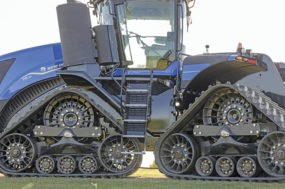Apples were not the only thing being harvested, so all hands were up to their armpits in alligators. The powers that be told me I had the short straw and to go see what was going on with the apple truck.
The truck was as far off the road on the right side as possible without the soft shoulder laying it on its side. Naturally, the flat tire was on the road side.
The service truck was parked behind the truck and farther off the road than the truck. The truck was at the base of a substantial hill, and one of the complaints the shop crew had was that traffic was not slowing down or pulling over to make it safe for them to work.
I parked my pickup so it took up half a lane of the road, with the four-way flashers on. Traffic coming down the hill would have to move over or hit the pickup.
The first thing I asked the guys, not very politely I’m afraid, was why they had not parked the service truck so it protected their precious rear ends. I then suggested that if the service truck blocking the road was not adequate, they could have pulled the whole apple truck onto the road, blocking traffic from both directions if necessary. Told them they could change 10 tires before the local law and order would be able to muster a car in that remote no-man’s-land to speak to them about obstructing traffic, which would still be better than scraping either of their carcasses from the pavement with a stick and a spoon.
One of the ten lug nuts on the wheel with the flat was being recalcitrant. The guys were alternately hammering away at it with the one-inch drive air impact wrench and smoking while cursing at it. I found a 4-pound sledgehammer. I had them wait until the air compressor built up a maximum charge of air. Then I had them hit the troublesome nut a couple of beats the wrong way, tightening rather than loosening.
I explained that sometimes this will rattle the years-long rust buildup loose. They did.
“Now hit it to take off the nut.”
There was about eight inches of the shank of the air gun exposed between the tire and the air tool. As the guys pulled the trigger, and the air wrench proceeded to deafen us, I hit the shank as hard as I could with the sledgehammer. About the fifth hit, the recalcitrant nut spun free. The additional shock waves from the sledge added just enough to jar loose whatever rust and grime had been cementing the nut to the wheel.
Wide-eyed, the guys wanted to know where I’d learned that trick.
“It’s a secret of the trade,” I told them. “If you tell anybody that I showed it to you, they’ll kill me.”
The first time I’d seen that trick used was with guys using hand tools to remove a wheel from a truck. Hand tools include a dog-bone-looking shaft of which one end fits the outer nut on Budd wheels and the other the inner. Near both ends is an opening for a bar to be inserted and, on a good day with twisting force applied, loosen the lug nuts. On a recalcitrant nut, this works best to solidly support the end opposite the nut, to hold it square and steady while force is applied. A stack of wood blocks or a jack stand work equally well.
The two-foot bar wasn’t doing it. Neither was the four-foot cheater pipe with the 250-pound hay hauler on the other end. So with the 250-pound guy off the ground on the end of the cheater pipe, his helper struck the shank of the tool with all his might. About the third blow of the sledgehammer, the nut turned.
I don’t remember where or when I learned this, but it seems so “common sense” I have trouble realizing that not everyone is aware of how to use some shock force to loosen rusted nuts.
Here’s another “secret of the trade.” If you see an old hand doing something in a way you’re not familiar with, and seems to have better results than how you’ve been doing it, odds are that he (or she) will be delighted to share with you and most likely spend time with you so you fully understand the proven “better way.”
Like the day the old guy stopped at the shop to ask directions. We were discussing how to sharpen a drill bit. He asked if we’d like him to show us how to sharpen a drill bit. It wasn’t a fair trade. He only needed simple directions. The ten minutes he spent demonstrating and then coaching while I sharpened a bit until he was confident I understood what I was doing has saved me many hours over the years.
Observe. Listen. Ask questions. Most of the time the guys who built it are not smarter than you are. ![]()










